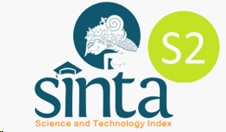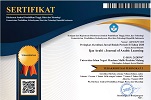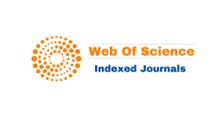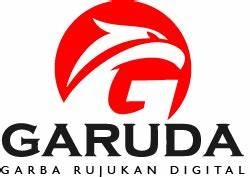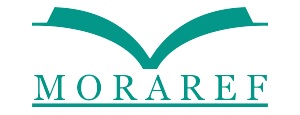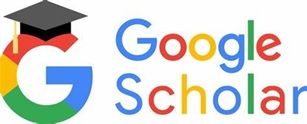The Dynamic Of Arabic Academic Writing In Postgraduate Program: Linguistic Corpus Analysis
Abstract
This descriptive library research describes the active research topics and methods most interested postgraduate students majoring in Arabic in master's and doctoral degrees. It explains the representation of research dynamic map in Arabic learning supported by corpus linguistic analysis. This research applied two research approaches; the quantitative approach was used to describe the frequency of words used by the postgrad students in their academic writings analyzed by Antconc software. A qualitative approach was used to explain the representation of corpus-based findings. The data are taken from abstracts of Arabic academic writings belonging to one of the Indonesian public universities’ digital libraries. The results showed that students' most popular research topics in the last five years are education topics, namely materials and textbooks development; second, linguistics topics such as naḥwu and tarkīb, and language skills is mahārah kalam. This study shows that students tend to research naḥwu and tarkīb based on speaking skills material. The most widely used students research method was Research and Development (R & R&D). Students tend to develop teaching materials with various perspectives, as R&D was a trend of research method. As a result, students are expected to gain an overview of the dynamic discourse map and research trends in Arabic learning as a foundation or preliminary research to select and determine research topics and methods for the final project. To avoid similarity, plagiarism, and saturation, one must choose variations in topics and types of research methods and follow existing trends.
Keywords
Full Text:
PDFReferences
Ahmed, M. A. I. (2013). The Functional Approach to Second Language Instruction. World Journal of English Language, 3(1), 92–105. https://doi.org/10.5430/wjel.v3n1p92
Al-Sulaiti, L., & Atwell, E. S. (2006). The design of a corpus of Contemporary Arabic. International Journal of Corpus Linguistics, 11(2). https://doi.org/10.1075/ijcl.11.2.02als
Alexander, L. G. (1979). A Functional/Notional Approach to Course Design. Audio-Visual Language Journal. https://www.mendeley.com/catalogue/9dd8a339-87c1-32f7-99bf-410491852cff/
Aljohani, M. (2017). Principles of “Constructivism” in Foreign Language Teaching. Journal of Literature and Art Studies, 7(1), 97–107. https://doi.org/10.17265/2159-5836/2017.01.013
Arifa, Z. (2017). The Successful Students’ Strategies to Solve the Problems of Arabic Academic Writing at State Islamic University Maulana Malik Ibrahim of Malang [Universitas Islam Negeri Maulana Malik Ibrahim Malang]. http://etheses.uin-malang.ac.id/16195/
Arifa, Z., & Al Faruq, U. (2021). Mapping the Research Theme and Method: A Corpus Based to Abstract of Arabic Education Undergraduate Program. Arabiyatuna : Jurnal Bahasa Arab, 5(1), 81. https://doi.org/10.29240/jba.v5i1.2073
Arifa, Z., & Hizbullah, N. (2019). al-Mudawwanah al-Nasshiyah al- Arabiyah lada Muta’allimy al-Arabiyah; Mash Sijliha biQismi Ta’limy al-Lughah al-Arabiyah. 503–510.
Atkins, S., Clear, J., & Ostler, N. (1992). Corpus design criteria. Literary and Linguistic Computing, 7(1), 1–16. https://doi.org/10.1093/llc/7.1.1
Baskara, F. X. R. (2017). Humanistic Language Learning in the 21 st Century Classroom : A Brief Look at Practice and Application. Seminar Dies Ke-24 Fakultas Sastra, April, 1–8.
Boulton, A., & Cobb, T. (2017). Corpus Use in Language Learning: A Meta-Analysis. Language Learning, 67(2), 348–393. https://doi.org/10.1111/lang.12224
Brian, P. (2004). Academic writing. In Language Teaching (Vol. 37, Issue 2, pp. 87–105). http://ejournals.ebsco.com/direct.asp?ArticleID=4726A86440696FF0514D
Dazdarevic, S., & Fijuljanin, F. (2015). Benefits of Corpus-Based Approach To Language Teaching. Balkan Distance Education Network - BADEN News Letter Year III, 7.
Development, R. S., & Team, I. (2013). Academic language/literacy strategies for adolescents: a “how to” manual for educators. In Choice Reviews Online (Vol. 47, Issue 12). https://doi.org/10.5860/choice.47-6988
Enfield, N. J. (2011). Micro-and macro-dimensions in linguistic systems. Reviewing Linguistic Thought: Converging Trends for the 21st Century, EnfIeld 2003, 313–326. https://doi.org/10.1515/9783110920826.313
Fitriani, L., & Arifa, Z. (2020). Project-based Learning in Promoting Active Learning for Arabic as Foreign Language Learners. Icri 2018, 590–595. https://doi.org/10.5220/0009912305900595
Ghofur, A. (2017). Dinamika Kajian Pendidikan Bahasa Arab Dalam Skripsi Mahasiswa Prodi Pendidikan Bahasa Arab. Arabiyatuna, 1(1). http://journal.staincurup.ac.id/index.php/arabiyatuna
Henning, E., Gravett, S., & van Rensburg, W. (2010). Finding your way in Academic Writing. 147.
Hizbullah, N., Arifa, Z., Suryadarma, Y., Hidayat, F., Muhyiddin, L., & Firmansyah, E. K. (2020). Source-based Arabic language learning: A corpus linguistic approach. Humanities and Social Sciences Reviews, 8(3), 940–954. https://doi.org/10.18510/HSSR.2020.8398
Hizbullah, N., & Muchlis, M. M. (2018). Projected Characteristics and Content of Arabic Corpus in Indonesia. Advances in Social Science, Education and Humanities Research (ASSEHR), 154(International Conference on Culture and Language in South East Asia (ICCLAS) 2017), 172–174. https://doi.org/doi:10.2991/icclas-17.2018.42
Hoque, M. (2020). Branches of Linguistics. Language, May, 14–17.
Mvududu, N. H., & Thiel-Burgess, J. (2012). Constructivism in Practice: The Case for English Language Learners. International Journal of Education, 4(3). https://doi.org/10.5296/ije.v4i3.2223
Nimehchisalem, V. (2018). Exploring Research Methods in Language Learning-teaching Studies. Advances in Language and Literary Studies, 9(6), 27. https://doi.org/10.7575/aiac.alls.v.9n.6p.27
Rahman, M. (2013). Humanistic Approaches to Language Teaching: from Theory to Practice. Stamford Journal of English, 4, 77–110. https://doi.org/10.3329/sje.v4i0.13491
Ridlo, U. (2015). Bahasa Arab dalam pusaran arus globalisasi: Antara pesismisme dan optimisme. Ihya Al-’Arabiyah, 1(2), 210–226. http://ejournalpba.org/index.php/ihya/article/view/92
Saleh, Z. (2016). Pendidikan bahasa arab dan social ; kajian terhadap realita , orientasi dan tantangan pendidikan bahasa arab. Turats. http://ejournal.iain-tulungagung.ac.id/index.php/taalum/article/download/356/289
Schenk, N. (2016). Corpus Linguistics - Introduction to Corpus Linguistics Corpora, Creation & Applications.
Swales, J. M., Feak, C. B., Johns, A. M., & Arbor, A. (2004). Academic Writing for Graduate Students: Essential Tasks and Skills (Michigan Series in English for Academic & Professional Purposes). Michigan Series, USA Course Prerequisites English Language Skills at the Level B2 According to CEFR.
Troudi, S., & Nunan, D. (1995). Research Methods in Language Learning. TESOL Quarterly, 29(3), 601. https://doi.org/10.2307/3588081
Vyatkina, N., & Boulton, A. (2017). Corpora in language learning and teaching: Discussant’s summary. Language and Learning Technology, 21(3), 1–8.
Wahab, M. A. (2007a). Peta Wacana Studi Bahasa Arab di UIN Jakarta (Analisis Substansi dan Metodologi Skripsi Mahasiswa Jurusan PBA-FITK). Narasi, 4(Desember), 1–19. http://repository.uinjkt.ac.id/dspace/bitstream/123456789/28268/3/Muhbib Abdul Wahab-FITK.pdf
Wahab, M. A. (2007b). Tantangan dan Prospek Pendidikan Bahasa Arab di Indonesia. Afaq Arabiyah, 2(1), 1–18. http://repository.uinjkt.ac.id/dspace/bitstream/123456789/28299/3/MUHBIB ABDUL WAHAB-FITK.pdf
Widdowson, H. G. (2003). Defining Issues in English Language Teaching. Oxford University Press.
Yigitoglu, N. (2010). Review of: Academic writing and plagiarism: A linguistic analysis. Journal of English for Academic Purposes, 9(3), 223–225. https://doi.org/10.1016/j.jeap.2010.06.002
Zaghouani, W., Bouamor, H., Hawwari, A., Diab, M., Obeid, O., Ghoneim, M., Alqahtani, S., & Oflazer, K. (2016). Guidelines and framework for a large scale Arabic diacritized corpus. Proceedings of the 10th International Conference on Language Resources and Evaluation, LREC 2016. https://www.mendeley.com/catalogue/bae63ee7-7650-3d82-a377-686085f3f77b/
Zaki, M. (2017). Corpus-based teaching in the Arabic classroom: theoretical and practical perspectives. International Journal of Applied Linguistics (United Kingdom), 27(2). https://doi.org/10.1111/ijal.12159
DOI: https://doi.org/10.18860/ijazarabi.v5i1.13251
Refbacks
- There are currently no refbacks.
Copyright (c) 2022 Zakiyah Arifa, Umar Al Faruq, Nur Hizbullah, Haslina Hassan
License URL: https://creativecommons.org/licenses/by-sa/4.0/






